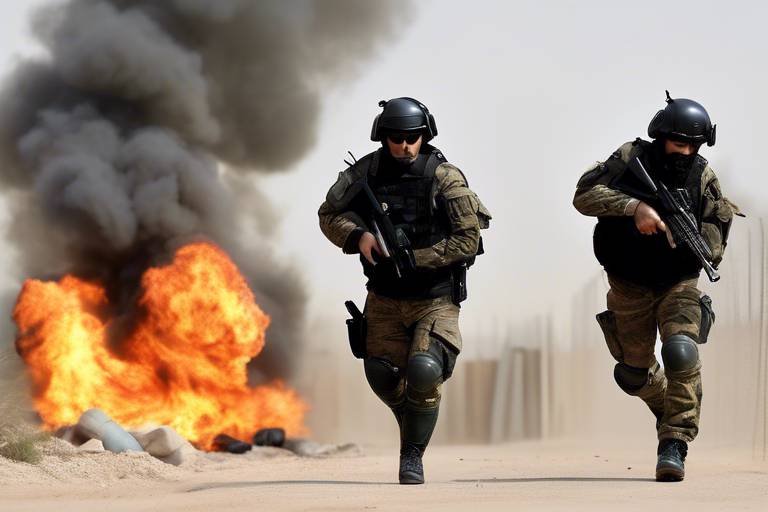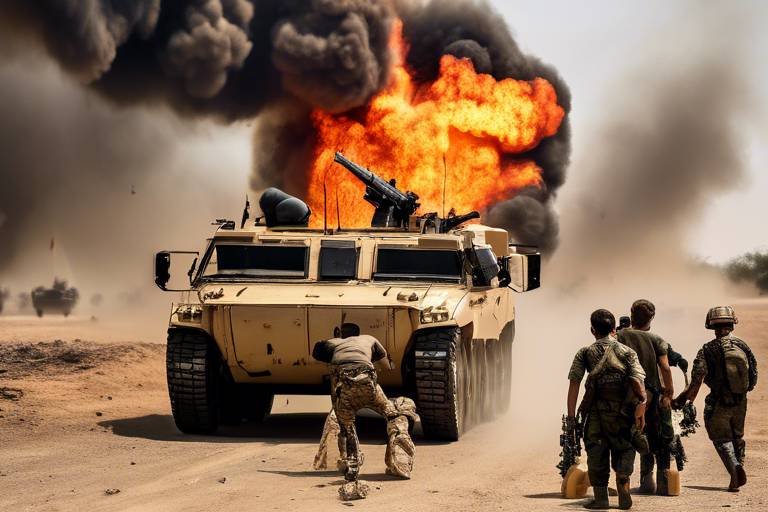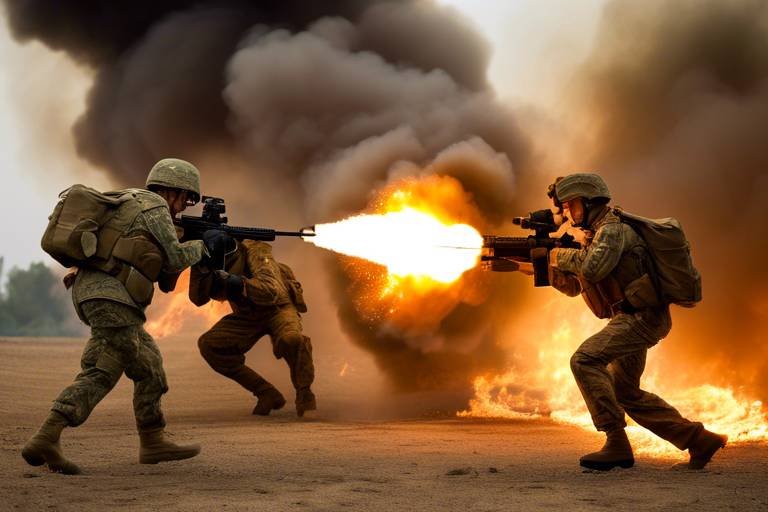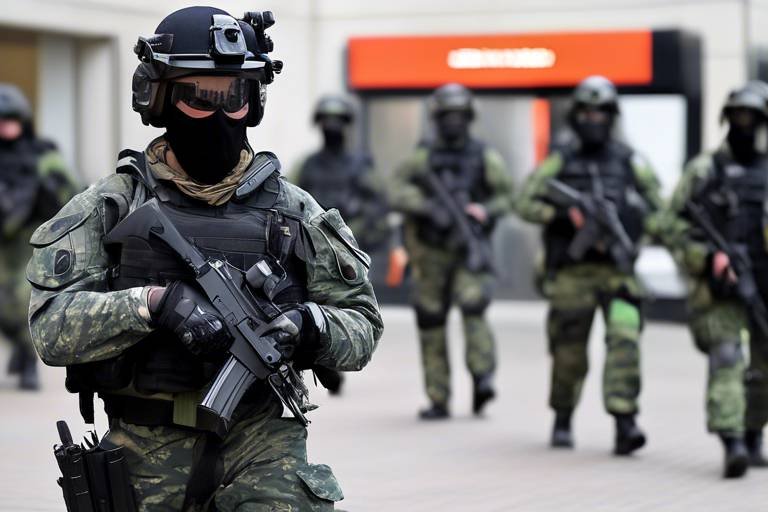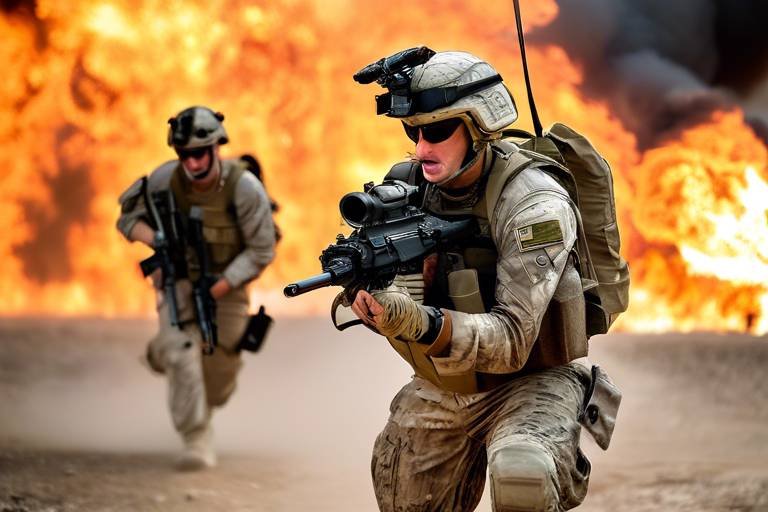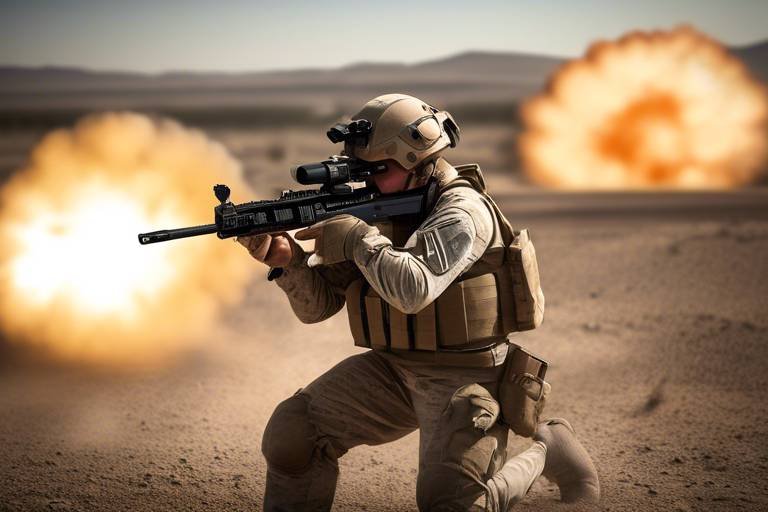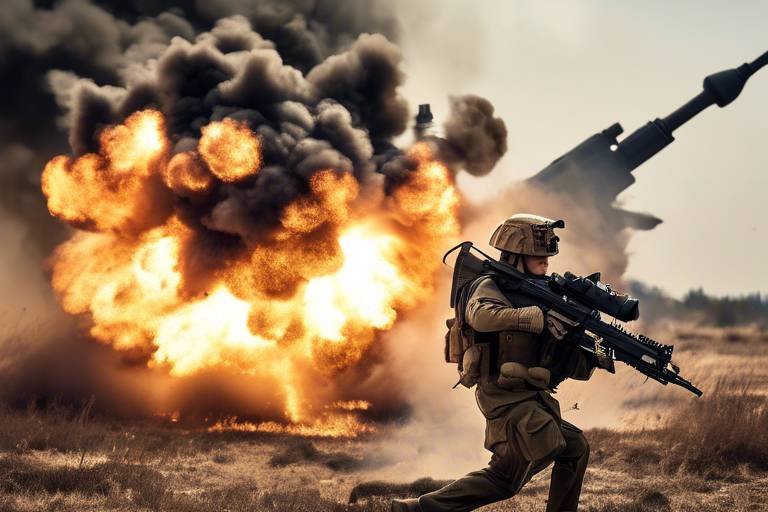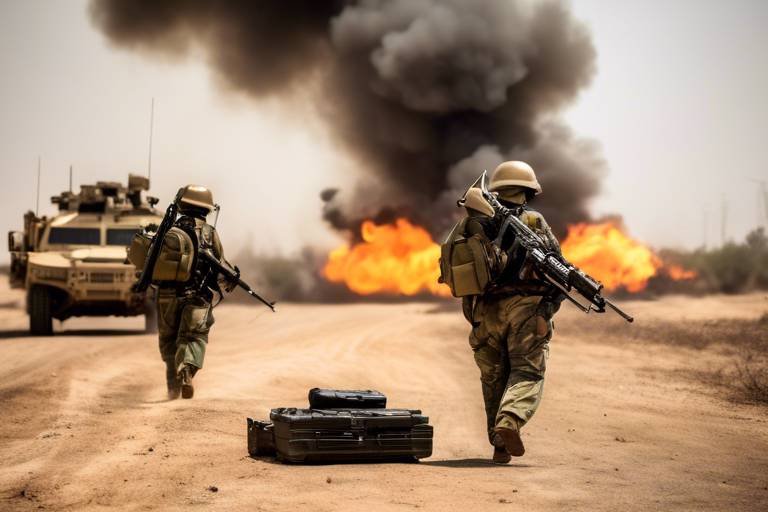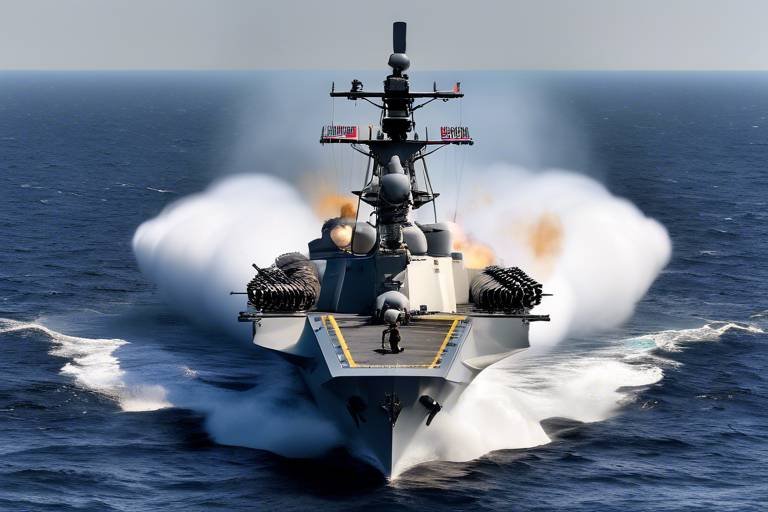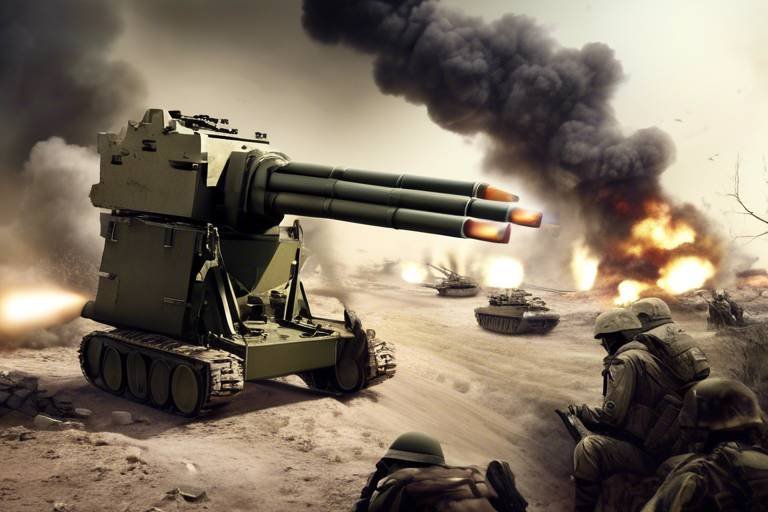How International Treaties Impact Weapon Development
The intricate relationship between international treaties and weapon development is a fascinating yet complex topic. Imagine a world where nations come together to agree on the rules of engagement, much like players in a game setting boundaries to ensure fair play. This is essentially what international treaties aim to achieve in the realm of military capabilities. These legal frameworks do not merely exist on paper; they actively shape the evolution of weaponry, influencing how countries develop, deploy, and manage their military assets.
International treaties serve as a guiding force, establishing standards that nations must adhere to, promoting disarmament initiatives, and encouraging responsible behavior in weapon development. For instance, treaties like the Treaty on the Non-Proliferation of Nuclear Weapons (NPT) and the Arms Trade Treaty (ATT) are key players in this arena. They not only set the tone for compliance but also create an environment where technological advancements in military capabilities are scrutinized and regulated.
Furthermore, these treaties can act as a double-edged sword. On one hand, they foster cooperation and trust among nations, leading to reduced tensions and increased security. On the other hand, they can also lead to tensions when nations feel that their security is compromised by the limitations imposed by these agreements. This dynamic is crucial to understanding how international treaties can both promote peace and inadvertently fuel arms races.
In the broader context, the impact of international treaties on weapon development cannot be overstated. They not only affect the strategies of nuclear and non-nuclear states but also have a ripple effect on regional security dynamics. As we delve deeper into this topic, we will explore historical treaties, their implications for weapon development, and the challenges that nations face in adhering to these agreements.
So, how do these treaties actually influence the development of weapons? Let’s take a closer look at some of the most significant treaties and their lasting impacts on global military capabilities.
The Role of International Law in Weapon Development
International law serves as a fundamental framework that governs the development of weapons across the globe. It lays down the rules and regulations that nations must follow, ensuring that military advancements do not spiral out of control. Think of international law as the referee in a high-stakes game—without it, players might take liberties that could lead to chaos. In the context of weapon development, these laws help maintain a delicate balance between national security and global peace.
At its core, international law aims to promote disarmament and prevent the proliferation of dangerous weapon systems. For instance, treaties like the Treaty on the Non-Proliferation of Nuclear Weapons (NPT) and the Arms Trade Treaty (ATT) set specific standards that countries are expected to adhere to. These agreements not only discourage the development of certain types of weapons but also encourage nations to engage in dialogue and cooperation, ultimately fostering a more secure world.
Moreover, international law plays a pivotal role in shaping technological advancements in military capabilities. By establishing legal frameworks, it influences research and development priorities. Countries are often compelled to align their weapon development strategies with international norms to maintain their credibility and standing on the world stage. This can be likened to a company needing to comply with industry regulations; failure to do so could result in reputational damage and loss of market share.
Despite these frameworks, challenges persist. Nations may sometimes prioritize their national interests over international obligations. This often leads to a grey area where compliance becomes a matter of convenience rather than commitment. For example, countries might develop advanced military technologies under the guise of national defense while skirting the edges of international law. The result? A complex landscape where the development of weapons can escalate tensions rather than mitigate them.
In conclusion, international law plays an essential role in weapon development by setting standards and promoting disarmament initiatives. However, the effectiveness of these legal frameworks hinges on the commitment of nations to adhere to them. As global security dynamics continue to evolve, the importance of international law in regulating weapon development will only increase, highlighting the need for ongoing dialogue and cooperation among states.
- What is the main purpose of international law in weapon development?
International law aims to regulate weapon development, promote disarmament, and prevent the proliferation of dangerous weapons. - How do treaties influence military capabilities?
Treaties set standards that nations must follow, thereby shaping their research and development priorities in military technology. - What challenges exist in treaty compliance?
Nations often prioritize their national interests, leading to situations where compliance with international agreements may be overlooked. - Why is international law compared to a referee?
Just like a referee maintains order in a game, international law helps ensure that nations adhere to agreed-upon norms and standards in weapon development.
Historical Overview of Major Treaties
The landscape of international relations and military capabilities has been profoundly shaped by a series of pivotal treaties throughout history. These agreements not only set the stage for cooperation among nations but also laid down the legal frameworks that govern the development and use of weaponry. Among these, the Treaty on the Non-Proliferation of Nuclear Weapons (NPT) and the Arms Trade Treaty (ATT) stand out as monumental achievements in the quest for global security and disarmament.
The NPT, established in 1968, represents a cornerstone in the effort to prevent the spread of nuclear weapons. Its primary objectives are threefold: to promote disarmament, to prevent the proliferation of nuclear weapons, and to encourage the peaceful use of nuclear energy. The NPT has not only influenced nuclear-armed states to reconsider their arsenals but has also played a vital role in fostering dialogue and trust among nations. The treaty has established a framework for nuclear disarmament negotiations, compelling nuclear states to engage in discussions aimed at reducing their stockpiles.
On the other hand, the Arms Trade Treaty (ATT), which came into force in 2014, focuses on regulating the international trade of conventional weapons. Its goal is to prevent the illicit arms trade that fuels conflicts and human rights abuses. The ATT obligates signatory states to assess the potential risks of arms transfers, ensuring that weapons do not end up in the hands of those who may misuse them. This treaty has been instrumental in promoting responsible arms trade practices and has had a ripple effect on national legislation regarding arms exports.
| Treaty | Year Established | Main Objectives |
|---|---|---|
| Nuclear Non-Proliferation Treaty (NPT) | 1968 | Prevent nuclear proliferation, promote disarmament, encourage peaceful nuclear energy |
| Arms Trade Treaty (ATT) | 2014 | Regulate international arms trade, prevent illicit transfers, promote responsible practices |
Both the NPT and the ATT have not only shaped the policies of individual nations but have also influenced global security dynamics. They serve as reminders of the collective responsibility that nations share in maintaining peace and security. However, the effectiveness of these treaties often hinges on the political will of the states involved and their commitment to uphold the principles laid out within these agreements.
As we delve deeper into the historical context of these treaties, it becomes clear that their impact extends beyond mere legal obligations. They represent a shared vision for a safer world, one where nations can coexist without the looming threat of nuclear annihilation or the devastation wrought by uncontrolled arms trade. The ongoing evolution of these treaties will likely continue to shape the future of weapon development and international relations.
- What is the main purpose of the NPT? The NPT aims to prevent the spread of nuclear weapons and promote disarmament while allowing for the peaceful use of nuclear energy.
- How does the ATT influence arms trade? The ATT regulates international arms transfers, requiring states to assess the risks of arms sales and to prevent weapons from reaching those who may misuse them.
- What challenges do treaties face in terms of compliance? Compliance can be hindered by national security interests, lack of political will, and challenges related to verification mechanisms.
The Nuclear Non-Proliferation Treaty (NPT)
The Nuclear Non-Proliferation Treaty (NPT) is one of the most significant international agreements aimed at preventing the spread of nuclear weapons. Established in 1968, this treaty has created a framework that not only seeks to limit the number of nuclear-armed states but also promotes the peaceful use of nuclear energy. Imagine a world where nations are encouraged to share their scientific advancements for peaceful purposes rather than hoarding destructive capabilities. This is the essence of the NPT, a delicate balance between disarmament and development.
At its core, the NPT is built on three pillars: non-proliferation, disarmament, and the right to peaceful use of nuclear energy. Each pillar plays a crucial role in shaping the policies of both nuclear and non-nuclear states. For nuclear-armed states, the treaty serves as a reminder of their obligations to engage in disarmament negotiations. This is not just a moral responsibility; it affects their international standing and relations with other nations. On the other hand, non-nuclear states are encouraged to refrain from developing nuclear weapons, which helps to create a more stable global security environment.
To put it simply, the NPT is like a global safety net. It aims to prevent the domino effect of nuclear proliferation, where one nation’s acquisition of nuclear weapons could lead others to follow suit. The implications are profound: a world without the NPT could very well be a world where nuclear arms races become the norm, leading to heightened tensions and insecurity.
However, the effectiveness of the NPT is often put to the test. For instance, some countries have been accused of non-compliance, either by pursuing clandestine nuclear programs or failing to engage in meaningful disarmament talks. This raises critical questions: How do we ensure compliance? What mechanisms are in place to hold nations accountable? The answers are complex and often rely on international diplomacy and cooperation.
Moreover, the NPT has sparked a debate about the legitimacy of nuclear deterrence. While some argue that possessing nuclear weapons is essential for national security, others contend that this mindset perpetuates a cycle of fear and mistrust. The challenge lies in reconciling these differing views while adhering to the treaty's objectives.
| Pillar | Description |
|---|---|
| Non-Proliferation | Preventing the spread of nuclear weapons and technology. |
| Disarmament | Engaging in negotiations to reduce and eliminate nuclear arsenals. |
| Peaceful Use | Promoting the use of nuclear energy for peaceful purposes. |
In conclusion, the NPT is not just a legal document; it represents a collective commitment to a safer world. It challenges nations to weigh their security needs against global stability and peace. As we move forward, the effectiveness of the NPT will depend on the willingness of states to cooperate and uphold their commitments. After all, the stakes are too high to ignore.
- What is the main goal of the NPT? The primary aim is to prevent the spread of nuclear weapons and promote disarmament.
- When was the NPT established? The NPT was opened for signature on July 1, 1968.
- How many countries are parties to the NPT? As of now, there are 191 parties to the NPT.
- What are the consequences of non-compliance? Non-compliance can lead to international sanctions and diplomatic isolation.
Impact on Nuclear States
The Nuclear Non-Proliferation Treaty (NPT) has a profound impact on nuclear-armed states, shaping their policies and approaches toward disarmament and weapon development. By establishing a framework that encourages dialogue and negotiation, the NPT creates a platform for nuclear states to engage in discussions about reducing their arsenals and enhancing security. This engagement is not merely a formality; it influences their military strategies and international relations significantly.
For instance, countries like the United States and Russia, which possess substantial nuclear stockpiles, have historically used the NPT as a basis for bilateral and multilateral disarmament negotiations. These discussions have led to various arms reduction agreements, such as the Strategic Arms Reduction Treaty (START). Through such treaties, nuclear states commit to reducing their nuclear warheads and delivery systems, ultimately affecting their weapon development programs.
Moreover, the NPT encourages nuclear-armed states to adopt a more responsible stance regarding their arsenals. They are often scrutinized by the international community, which holds them accountable for their commitments. Failure to comply can result in diplomatic repercussions, economic sanctions, and a tarnished global reputation. This pressure can compel these nations to reconsider their weapon development strategies and prioritize transparency and disarmament.
However, the impact of the NPT is not uniform across all nuclear states. Some nations, like North Korea, have demonstrated a blatant disregard for the treaty, pursuing their nuclear ambitions despite international condemnation. This behavior raises critical questions about the efficacy of the NPT in enforcing compliance and maintaining global security. As a result, the international community must continuously adapt its strategies to address the evolving landscape of nuclear proliferation.
In summary, the influence of the NPT on nuclear states extends beyond mere compliance; it shapes their defense policies, international standing, and weapon development strategies. The ongoing dialogue fostered by the treaty is essential for promoting disarmament and preventing the further spread of nuclear weapons. As global security dynamics shift, the role of nuclear states within this framework will remain crucial in determining the future of international peace and stability.
- What is the purpose of the Nuclear Non-Proliferation Treaty (NPT)?
The NPT aims to prevent the spread of nuclear weapons, promote disarmament, and facilitate the peaceful use of nuclear energy. - How do nuclear states influence the NPT?
Nuclear states engage in disarmament negotiations and are held accountable for their commitments, which shapes their weapon development strategies. - What happens if a nuclear state violates the NPT?
Violating the NPT can lead to diplomatic repercussions, economic sanctions, and a damaged international reputation. - Are there any successful disarmament agreements resulting from the NPT?
Yes, treaties like the Strategic Arms Reduction Treaty (START) have emerged from NPT discussions, leading to significant reductions in nuclear arsenals.
Influence on Non-Nuclear States
The impact of the Nuclear Non-Proliferation Treaty (NPT) on non-nuclear states is profound and multifaceted. By encouraging these nations to refrain from developing nuclear weapons, the NPT significantly shapes their defense policies and military strategies. Non-nuclear states often find themselves at a crossroads, balancing their national security interests with their commitments under international law. This dynamic creates a unique context in which these countries must navigate their defense capabilities while adhering to global norms.
For many non-nuclear states, the NPT serves as a framework that promotes stability and security within their regions. By committing to non-proliferation, these countries can foster trust and cooperation among neighboring states, which can lead to enhanced diplomatic relations. This is especially crucial in volatile regions where the threat of nuclear escalation looms large. Countries that embrace the principles of the NPT often find themselves in a position to advocate for disarmament and peaceful conflict resolution, which can further strengthen their international standing.
Moreover, non-nuclear states are often incentivized to invest in conventional military capabilities rather than pursuing nuclear arsenals. This shift can lead to advancements in technology and military innovation that align with international standards. For instance, many of these countries focus on developing advanced conventional weaponry, enhancing their defense systems, and participating in international peacekeeping missions. By doing so, they not only comply with the NPT but also contribute to global security efforts.
However, the influence of the NPT on non-nuclear states is not without its challenges. Some nations may feel pressured to develop their own nuclear capabilities as a means of deterrence, especially if they perceive threats from nuclear-armed neighbors. This creates a paradox where the very treaty meant to promote peace and security could inadvertently lead to increased tensions. Thus, the NPT's effectiveness relies heavily on the political will of nuclear-armed states to engage in disarmament and on the commitment of non-nuclear states to uphold their obligations.
In summary, the influence of the NPT on non-nuclear states is a double-edged sword. While it fosters a climate of security and cooperation, it also presents challenges that can lead to complex geopolitical dynamics. Non-nuclear states must navigate these waters carefully, balancing their security needs with their commitments to international treaties. As the landscape of global security continues to evolve, the role of non-nuclear states in promoting disarmament and fostering peace will be more critical than ever.
- What is the primary goal of the NPT? The primary goal of the NPT is to prevent the spread of nuclear weapons and promote disarmament while allowing for peaceful uses of nuclear energy.
- How do non-nuclear states benefit from the NPT? Non-nuclear states benefit from the NPT by gaining security assurances and fostering international cooperation, which can enhance their diplomatic relations and regional stability.
- What challenges do non-nuclear states face regarding the NPT? Non-nuclear states may face challenges such as regional threats from nuclear-armed neighbors, which can create pressure to develop their own nuclear capabilities.
- How do non-nuclear states contribute to global security? Non-nuclear states contribute to global security by promoting disarmament, participating in peacekeeping missions, and enhancing their conventional military capabilities in line with international standards.
Arms Trade Treaty (ATT)
The is a landmark agreement that aims to regulate the international trade of conventional weapons. Established in 2013, this treaty seeks to prevent the illicit transfer of arms and to promote responsible trading practices among nations. By setting clear standards for the transfer of conventional arms, the ATT plays a crucial role in shaping the development and proliferation of weaponry on a global scale. It is not just a legal framework; it is a commitment to uphold human rights and maintain peace and security worldwide.
One of the key objectives of the ATT is to ensure that arms transfers do not contribute to human rights abuses or exacerbate conflicts. This means that countries are required to assess the potential consequences of their arms exports before proceeding with any transactions. For instance, if there is a risk that the arms could be used to commit atrocities or fuel violence, the exporting nation is obligated to withhold the transfer. This responsibility underscores the importance of ethical considerations in arms trading, pushing nations to think critically about their role in global security.
Moreover, the ATT has significant implications for weapon development strategies across the globe. Countries that are party to the treaty must align their domestic laws and regulations with its stipulations, which can lead to changes in how they approach military procurement and research. For example, nations may prioritize the development of less destructive technologies or invest in systems that enhance transparency and accountability in their defense sectors. This shift not only affects the types of weapons being developed but also influences the overall military capabilities of nations.
Despite its noble intentions, the ATT faces numerous challenges. Compliance varies significantly among member states, with some countries lacking the infrastructure or political will to fully implement the treaty's provisions. Furthermore, the existence of loopholes and the ongoing demand for arms in conflict zones complicate efforts to enforce the treaty effectively. The need for robust verification mechanisms is paramount, yet many nations are hesitant to share sensitive information regarding their arms transfers, leading to a lack of transparency. This situation raises the question: how can the international community ensure that the ATT remains effective in a world where national interests often take precedence over global agreements?
In conclusion, the Arms Trade Treaty represents a crucial effort to regulate the international arms trade and promote responsible weapon development. While its implementation has faced challenges, the ATT continues to serve as a guiding framework for nations seeking to enhance global security and prevent the misuse of arms. As we look to the future, the effectiveness of the ATT will depend on the collective commitment of nations to uphold its principles and adapt to the evolving landscape of international security.
- What is the Arms Trade Treaty (ATT)? The ATT is an international agreement that regulates the trade of conventional weapons to prevent illicit transfers and promote responsible practices.
- When was the ATT established? The ATT was established in 2013 and has been signed by numerous countries worldwide.
- What are the key objectives of the ATT? The key objectives include preventing human rights abuses, promoting responsible arms trading, and ensuring that arms transfers do not exacerbate conflicts.
- What challenges does the ATT face? Challenges include varying levels of compliance among nations, lack of transparency, and political will to implement its provisions.
The Influence of Regional Treaties
Regional treaties play a pivotal role in shaping the military landscape and security dynamics within specific geographic areas. These agreements are often tailored to address the unique challenges and historical contexts of a region, making them crucial for fostering cooperation and promoting peace. For instance, treaties like the Treaty of Tlatelolco and the African Nuclear-Weapon-Free Zone Treaty not only aim to prevent the proliferation of nuclear weapons but also to create a framework for collective security among member states. By establishing norms and expectations, these treaties influence how countries approach weapon development and military capabilities.
One of the most significant impacts of regional treaties is their ability to create nuclear-weapon-free zones. These zones effectively prohibit the development, testing, and deployment of nuclear weapons within a designated area, thereby encouraging disarmament and peaceful resolutions to conflicts. For example, the Treaty of Tlatelolco, signed in 1967, established Latin America as a nuclear-weapon-free zone. This treaty not only curtailed the nuclear ambitions of member states but also fostered a spirit of cooperation and trust among nations that had previously been adversaries.
Similarly, the African Nuclear-Weapon-Free Zone Treaty, which came into force in 2009, seeks to promote disarmament and prevent the spread of nuclear weapons across the African continent. By creating a legally binding commitment to refrain from developing nuclear arms, this treaty shapes national defense policies and encourages states to focus on conventional military capabilities instead. The emphasis on disarmament reinforces the idea that security can be achieved through diplomatic means rather than through the accumulation of weapons.
Moreover, regional treaties often serve as a platform for dialogue and collaboration on security issues. They can facilitate discussions on arms control, disarmament, and confidence-building measures, which are essential for maintaining stability in volatile regions. By bringing nations together, these treaties help to build trust and promote transparency—a crucial factor in reducing the likelihood of conflict. The influence of regional treaties extends beyond mere regulations; they also embody a collective commitment to peace and security that resonates with the populations of the member states.
However, the effectiveness of these treaties is often challenged by external factors, such as geopolitical tensions and national interests. Some countries may prioritize their security needs over treaty obligations, leading to a complex interplay between regional agreements and global security dynamics. The success of regional treaties in influencing weapon development hinges on the political will of member states to adhere to their commitments and the ability to address the underlying security concerns that may drive them to develop advanced military capabilities.
In conclusion, regional treaties significantly influence weapon development and security policies within specific areas. By establishing norms and fostering cooperation, they contribute to a more stable and secure global environment. However, the challenges of compliance and competing national interests highlight the need for ongoing dialogue and collaboration among nations to ensure that these treaties remain effective in promoting disarmament and peace.
- What are regional treaties? Regional treaties are agreements between countries within a specific geographic area aimed at addressing security concerns, often focusing on disarmament and arms control.
- How do regional treaties influence weapon development? They establish norms and regulations that discourage the proliferation of weapons, promoting peace and cooperation among member states.
- Can regional treaties prevent conflicts? While they cannot guarantee the absence of conflict, they can foster dialogue and build trust, which are essential for conflict prevention.
- What challenges do regional treaties face? Compliance can be difficult due to national interests and geopolitical tensions, which may lead some countries to prioritize their security over treaty obligations.
Case Study: The Treaty of Tlatelolco
The Treaty of Tlatelolco, formally known as the Treaty for the Prohibition of Nuclear Weapons in Latin America and the Caribbean, was signed in 1967 and represents a landmark achievement in the quest for nuclear disarmament. This treaty established a nuclear-weapon-free zone across a vast region, effectively prohibiting the development, testing, and deployment of nuclear weapons among its member states. By creating this zone, the treaty not only aimed to enhance regional security but also to promote peace and cooperation among Latin American countries. The significance of the Tlatelolco Treaty lies in its ability to influence regional politics and security dynamics, fostering an environment where diplomatic solutions take precedence over military options.
One of the most striking aspects of the Treaty of Tlatelolco is its comprehensive verification mechanism, which ensures that all member states comply with its provisions. This mechanism includes regular reporting and inspections, which serve to build confidence among nations in the region. However, the success of this treaty is not solely attributed to its legal framework; it also hinges on the political will of the member states to adhere to its principles. The treaty has been instrumental in shaping the defense policies of signatory nations, encouraging them to focus on conventional defense capabilities rather than pursuing nuclear arsenals.
Moreover, the Treaty of Tlatelolco has had a profound impact on the global disarmament agenda. It serves as a model for other regions seeking to establish similar frameworks, demonstrating that collective security can be achieved through cooperation and mutual agreements. The treaty has not only curtailed the proliferation of nuclear weapons but has also fostered a culture of disarmament that resonates beyond Latin America. As a result, it has inspired various international initiatives aimed at achieving a world free of nuclear threats.
In conclusion, the Treaty of Tlatelolco stands as a testament to the potential of international treaties to influence weapon development and promote regional stability. Its legacy continues to inspire efforts toward disarmament and non-proliferation, proving that legal frameworks can play a crucial role in shaping military capabilities and international relations.
- What is the Treaty of Tlatelolco?
The Treaty of Tlatelolco is an international agreement that establishes a nuclear-weapon-free zone in Latin America and the Caribbean. - When was the Treaty of Tlatelolco signed?
The treaty was signed on February 14, 1967. - What are the main objectives of the Treaty of Tlatelolco?
The treaty aims to prevent the development and proliferation of nuclear weapons in the region, promoting peace and security among member states. - How does the treaty ensure compliance?
The treaty includes verification mechanisms such as regular reporting and inspections to ensure that member states adhere to its provisions. - Has the Treaty of Tlatelolco influenced other regions?
Yes, it has served as a model for other regions seeking to establish similar nuclear-weapon-free zones and has inspired global disarmament initiatives.
Case Study: The African Nuclear-Weapon-Free Zone Treaty
The African Nuclear-Weapon-Free Zone Treaty, commonly referred to as the Treaty of Pelindaba, stands as a significant milestone in the continent's commitment to disarmament and non-proliferation. Signed in 1996 and entering into force in 2009, this treaty not only prohibits the development, testing, and possession of nuclear weapons within Africa but also promotes peaceful uses of nuclear energy. The essence of the treaty lies in its aim to create a secure environment free from the threats posed by nuclear armaments, thereby fostering regional stability and cooperation.
One of the remarkable features of the African Nuclear-Weapon-Free Zone Treaty is its emphasis on regional collaboration. By establishing a nuclear-weapon-free zone, African nations are encouraged to work together to enhance their security frameworks. This collaborative spirit is pivotal, considering the historical context of colonialism and external interventions that have often destabilized the region. The treaty serves as a platform for African countries to unite against the proliferation of nuclear weapons, thereby reinforcing their sovereignty and collective security.
Moreover, the treaty has implications that extend beyond mere disarmament. It encourages member states to invest in peaceful nuclear technology, which can be utilized for various purposes such as energy generation, medical applications, and agricultural development. This push for peaceful applications of nuclear technology is crucial for the continent, as it seeks to harness nuclear energy to address pressing challenges like energy shortages and food security.
However, the African Nuclear-Weapon-Free Zone Treaty is not without its challenges. While many African nations have embraced the treaty, there are concerns regarding compliance and enforcement. The lack of robust verification mechanisms can lead to skepticism about the treaty’s effectiveness. For instance, the absence of a comprehensive monitoring system raises questions about whether all member states are genuinely adhering to the treaty’s provisions. Furthermore, political will varies among nations, often influenced by national interests that may conflict with the treaty’s objectives.
In addition, the geopolitical landscape surrounding Africa can complicate the treaty's implementation. The presence of external powers and their interests in the region can create tensions that undermine the treaty's goals. As such, it is imperative for African nations to not only focus on internal compliance but also engage in diplomatic efforts to ensure that external influences do not hinder their commitment to a nuclear-weapon-free continent.
In conclusion, the African Nuclear-Weapon-Free Zone Treaty represents a bold step toward disarmament and regional stability. By fostering collaboration among African nations and promoting the peaceful use of nuclear technology, the treaty aims to reshape the security landscape of the continent. However, for it to be truly effective, persistent efforts must be made to address compliance challenges and external influences. The future of Africa’s security may well depend on the successful implementation of this treaty and the unwavering commitment of its member states.
- What is the primary goal of the African Nuclear-Weapon-Free Zone Treaty?
The primary goal is to prohibit the development, testing, and possession of nuclear weapons in Africa, while promoting peaceful uses of nuclear energy. - When was the treaty signed and when did it enter into force?
The treaty was signed in 1996 and entered into force in 2009. - How does the treaty promote regional security?
By fostering cooperation among member states and creating a unified stance against nuclear proliferation, the treaty enhances collective security in the region. - What challenges does the treaty face?
Challenges include compliance and enforcement issues, lack of robust verification mechanisms, and the influence of external geopolitical factors.
Challenges in Treaty Compliance
Despite the noble intentions behind international treaties aimed at regulating weapon development, the reality is often far more complex. Nations frequently grapple with compliance challenges that can undermine the effectiveness of these agreements. At the heart of the issue lies a tension between national security interests and international obligations. Countries may prioritize their own strategic goals over adherence to treaties, leading to a patchwork of compliance that varies significantly across the globe.
One of the primary challenges is the verification mechanisms that are intended to ensure compliance. While treaties like the Nuclear Non-Proliferation Treaty (NPT) and the Arms Trade Treaty (ATT) include provisions for monitoring and verification, these mechanisms often face significant hurdles. Issues such as lack of transparency, insufficient resources, and limited cooperation among states can hinder effective verification. For instance, countries may be reluctant to share sensitive information about their military capabilities or weapon stockpiles, making it challenging for international bodies to assess compliance accurately.
Moreover, the political will of nations to adhere to treaties can fluctuate based on changing political landscapes and national interests. For example, a country facing security threats may feel compelled to develop or acquire advanced weaponry, even if it means violating international agreements. This creates a paradox where the very treaties designed to promote peace and stability can be undermined by the actions of states acting in what they perceive to be their own best interests.
Additionally, the diverse geopolitical contexts in which treaties operate can further complicate compliance. Nations in regions with ongoing conflicts or historical animosities may view treaties with skepticism, fearing that compliance could leave them vulnerable to adversaries. This can lead to a reluctance to fully engage with treaty obligations, thereby perpetuating a cycle of distrust and non-compliance.
In summary, while international treaties play a vital role in regulating weapon development, the challenges of compliance are significant and multifaceted. Nations must navigate a complex landscape of national interests, verification challenges, and geopolitical dynamics that can all impact their willingness and ability to adhere to these important agreements. Addressing these challenges will require a concerted effort from the international community to foster cooperation, enhance verification mechanisms, and build trust among nations.
- What are the main challenges in complying with international treaties?
The main challenges include national security interests often taking precedence over treaty obligations, verification difficulties, and fluctuating political will among nations.
- How do verification mechanisms work?
Verification mechanisms are designed to monitor compliance with treaties, but they can face challenges such as lack of transparency and cooperation among states.
- Why do some countries violate treaties?
Countries may violate treaties due to perceived security threats, national interests, or skepticism regarding the effectiveness of the treaties themselves.
Verification Mechanisms
Verification mechanisms are the backbone of ensuring compliance with international treaties related to weapon development. These systems are designed to monitor, assess, and confirm that nations are adhering to their commitments, ultimately fostering a sense of trust and accountability among countries. However, the effectiveness of these mechanisms often faces significant hurdles. One of the primary challenges is the issue of transparency. Nations may be reluctant to share sensitive information regarding their military capabilities or weapon stockpiles, fearing that such disclosures could compromise their national security. This opacity can lead to suspicions and undermine the very purpose of the treaties.
Moreover, the political landscape plays a crucial role in the enforcement of verification mechanisms. Countries may exhibit varying levels of political will to comply with treaty obligations. For instance, a nation facing external threats might prioritize its defense capabilities over international agreements, leading to a potential breach of compliance. The fluctuating nature of political interests can complicate the landscape of verification, making it difficult to maintain a consistent and reliable framework.
To illustrate the complexities involved, let's take a look at some key verification mechanisms used in international treaties:
| Verification Mechanism | Description | Challenges |
|---|---|---|
| Inspections | On-site inspections by international bodies to verify compliance. | Access denial by nations, limited scope of inspections. |
| Reporting Requirements | Regular submission of reports detailing weapon stockpiles and developments. | Inaccurate or misleading information provided by states. |
| Satellite Monitoring | Use of satellite technology to monitor military activities. | Technical limitations and potential misinterpretation of data. |
These mechanisms can serve as effective tools for fostering compliance, but they are not without their challenges. For instance, inspections may be met with resistance, as nations may perceive them as intrusive or threatening. Similarly, while reporting requirements can provide valuable insights, they are only as reliable as the information provided. This is where the importance of trust among nations comes into play; without a foundation of mutual respect and cooperation, verification efforts may falter.
In conclusion, while verification mechanisms are essential for maintaining the integrity of international treaties, their effectiveness hinges on transparency, political will, and the ability of nations to cooperate. As we navigate the complex world of weapon development and international relations, it is crucial to foster an environment where verification is not seen as a burden, but rather as a pathway to enhanced security and stability.
- What are verification mechanisms? Verification mechanisms are systems established to monitor and ensure compliance with international treaties regarding weapon development.
- Why is transparency important in verification? Transparency fosters trust among nations and ensures that compliance can be reliably assessed.
- What challenges do verification mechanisms face? Challenges include lack of cooperation from nations, political fluctuations, and the potential for inaccurate reporting.
- How do inspections work? Inspections involve on-site evaluations conducted by international bodies to verify compliance with treaty obligations.
Political Will and National Interests
The intersection of political will and national interests is a pivotal factor in the compliance and effectiveness of international treaties. Nations often find themselves at a crossroads, where the desire to adhere to global norms clashes with their own strategic priorities. This tug-of-war can lead to a variety of outcomes, from full compliance to outright defiance. For instance, while a country may publicly endorse a treaty aimed at disarmament, behind closed doors, its leaders might prioritize military advancements to bolster national security. This contradiction raises an important question: how do countries balance their obligations under international law with their own perceived needs for defense?
To understand this complex dynamic, it's essential to recognize that national interests are not static; they evolve based on a multitude of factors, including geopolitical tensions, economic considerations, and domestic politics. For example, a nation facing external threats may perceive the development of advanced weaponry as a necessary measure for survival, even if it means breaching treaty obligations. This scenario is not uncommon, as history has shown that nations often prioritize their sovereignty and security over international agreements, leading to a discrepancy between treaty commitments and actual behavior.
Moreover, the political landscape within a country can significantly influence its approach to treaties. Leaders who are committed to international cooperation may advocate for compliance, while those who lean towards nationalism might view treaties as constraints on their freedom to act. This internal struggle can manifest in various ways:
- Public Opinion: Leaders often gauge public sentiment before committing to international treaties. If the populace is skeptical of foreign agreements, political leaders may choose to ignore or withdraw from such commitments.
- Economic Factors: Economic stability can dictate a nation's willingness to engage in disarmament efforts. Nations facing economic downturns may prioritize military spending as a means of securing jobs and industries.
- International Relations: The relationships a country has with its allies and adversaries can also shape its treaty compliance. A nation may feel compelled to develop certain weapons to maintain a balance of power with a rival state.
In essence, the political will to comply with international treaties is often overshadowed by the pressing demands of national interests. This reality complicates the landscape of global security and weapon development, as nations navigate the fine line between international obligations and domestic imperatives. The challenge lies in fostering a political environment that values treaty compliance as a cornerstone of national security, rather than a hindrance to it. Only through a collective commitment to prioritize global stability over individual ambitions can we hope to see meaningful progress in the regulation of weapon development.
- What is the significance of political will in international treaties?
Political will is crucial as it determines whether nations will adhere to treaty obligations or prioritize their national interests. - How do national interests influence treaty compliance?
National interests often take precedence over international commitments, leading to selective compliance based on security needs and geopolitical considerations. - Can public opinion affect a country's approach to international treaties?
Yes, public sentiment can significantly influence political leaders' decisions regarding treaty commitments, especially if there is skepticism towards foreign agreements. - What role do economic factors play in treaty compliance?
Economic stability can dictate a nation's willingness to engage in disarmament, as countries facing economic challenges may prioritize military spending.
The Future of Weapon Development in a Treaty Framework
The landscape of weapon development is constantly shifting, influenced by a myriad of factors including technological advancements, geopolitical tensions, and most importantly, international treaties. As we look to the future, it becomes increasingly clear that the adaptability of these legal frameworks will play a crucial role in shaping military innovations and global security dynamics. But what does this mean for the future of weaponry? Will treaties be able to keep pace with the rapid evolution of military technology, or will they become outdated relics in a world where nations prioritize their own security?
One of the most pressing challenges is the emergence of new technologies such as artificial intelligence, cyber warfare, and autonomous weapon systems. These innovations not only change the nature of warfare but also complicate the regulatory landscape. As nations race to develop cutting-edge capabilities, the question arises: how can treaties effectively govern technologies that are still in their infancy? The answer lies in creating flexible and responsive frameworks that can adapt to the changing nature of warfare. This means that treaties must not only address current technologies but also anticipate future developments.
Furthermore, the geopolitical climate is ever-evolving. As power dynamics shift, the relevance of existing treaties may be called into question. For instance, how do treaties remain effective when major powers withdraw or violate their commitments? This unpredictability poses a significant risk to international stability. It emphasizes the need for a robust verification and compliance mechanism, ensuring that nations uphold their treaty obligations while fostering trust among states.
In addition, the role of regional treaties cannot be overlooked. They often serve as a testing ground for broader international agreements. For example, the success or failure of regional disarmament initiatives can provide valuable lessons for global treaties. Will regional treaties pave the way for more comprehensive agreements? The answer may lie in their ability to address specific local security concerns while contributing to global disarmament goals. This interplay between regional and international frameworks is essential for a cohesive approach to weapon development.
Moreover, the future of weapon development will also depend on the political will of nations. How committed are states to international cooperation? The fluctuating political landscape can significantly impact compliance with treaties. Nations often prioritize their own security interests, which can lead to selective adherence to international norms. This underscores the importance of diplomatic engagement and the need for states to recognize that collective security benefits everyone.
In conclusion, the future of weapon development within a treaty framework is a complex tapestry woven from the threads of technological innovation, geopolitical shifts, and national interests. As we navigate this intricate landscape, the effectiveness of international treaties will hinge on their ability to evolve and adapt. Will we see a new era of cooperation, or will self-interest prevail? Only time will tell, but one thing is certain: the stakes have never been higher.
- What role do treaties play in weapon development? Treaties establish legal frameworks that regulate the development and proliferation of weapons, promoting disarmament and responsible practices.
- How can treaties adapt to new technologies? Treaties must incorporate flexible provisions that allow for updates and revisions in response to emerging technologies and security challenges.
- What happens if a country violates a treaty? Violations can lead to diplomatic tensions, sanctions, and a breakdown of trust among nations, complicating future negotiations.
- Are regional treaties effective? Yes, regional treaties can address specific security concerns and serve as models for broader international agreements.
Frequently Asked Questions
- What is the role of international treaties in weapon development?
International treaties play a pivotal role in shaping the landscape of weapon development. They set legal frameworks that regulate the production, proliferation, and use of various weapons, ensuring that nations adhere to standards that promote global security and disarmament.
- How does the Nuclear Non-Proliferation Treaty (NPT) affect nuclear weapon states?
The NPT encourages nuclear-armed states to engage in disarmament negotiations and to limit the development of new nuclear weapons. This treaty significantly influences their military strategies and international relations, pushing them towards transparency and cooperation.
- What impact does the Arms Trade Treaty (ATT) have on conventional weapons?
The ATT aims to regulate the international trade of conventional weapons, preventing illicit transfers and promoting responsible practices. Its influence can be seen in how countries develop and trade arms while adhering to international norms.
- Are regional treaties important in the context of global security?
Absolutely! Regional treaties, like the Treaty of Tlatelolco and the African Nuclear-Weapon-Free Zone Treaty, play a crucial role in local security dynamics. They shape defense policies and promote disarmament in their respective regions, contributing to a more stable global environment.
- What are the challenges in complying with international treaties?
Compliance with international treaties can be challenging due to national security interests often taking precedence. Political will varies among nations, and verification mechanisms may face issues related to transparency and cooperation, complicating the enforcement of these agreements.
- How can the future of weapon development be influenced by treaties?
The future of weapon development will heavily rely on the adaptability and enforcement of international treaties. As global security dynamics change, these treaties will shape military innovations and geopolitical relations, determining how nations approach defense and disarmament.


